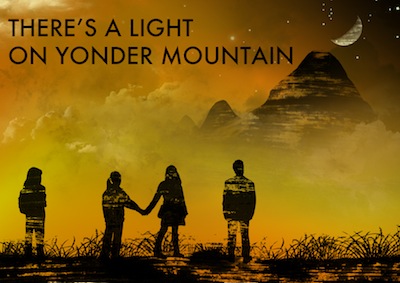 With exemplary use of creative engines to covey a story that at times lacked in clarity of the narrative and conviction of its characters’ goals, “There’s a Light on Yonder Mountain†ultimately proves to be a rewarding experience.
With exemplary use of creative engines to covey a story that at times lacked in clarity of the narrative and conviction of its characters’ goals, “There’s a Light on Yonder Mountain†ultimately proves to be a rewarding experience.
“There’s a Light on Yonder Mountain†explores the journey of four unlikely heroes called to a mysterious mission to change the world. Inspired by the American scholar, Joseph Campbell’s work on “The Hero’s Journey,†the play follows the structure of a monomyth, in which tales of heroes around the world follow the same pattern in a narrative — an unlikely hero emerges when they venture out of their common life to travel and encounter supernatural forces and return victorious with the wisdom and ability to better their fellow men.
The story begins with Steve (Paul Kite, “Leaving Ikea”), as he recruits a group of misfits for a peculiar mission. Kite’s commitment to the consistency of his character throughout the play is evident in his potent delivery that fits the odd, hopeful stranger.
In Yonder Mountain, Kite’s character assembles the heroes in the aftermath of the world ravaged by a deadly virus. It is a time where people have lost the old familiar sense of community, and with it, some essence of their humanity. Of the group, some of the most outstanding performances were delivered by Lauren Berst as Genevieve, Zac Hoogendyk as Adam and the multifaceted Bob Jaffe in a few various roles.
Berst was phenomenal as Genevieve. This allowed the audience to better understand the character’s burden as she took on the weight of the world. Hoogendyk’s Adam perhaps had the most coherent and visible character arc in the play. The evolution of his character was pleasant to watch. Anyone who has ever questioned his or her destiny or purpose can relate to Adam.
Jaffe was the most memorable of the bunch. He played both animate and inanimate roles ranging from the Neighbor, Thom and Noll to a tree and a rock. His characters were significantly different from one another and were executed well. Jaffe’s best character was Thom, a double-amputee from whom the team finds their purpose in their quest. By building a character that simply operates out of a wheelchair and two canes to move, it showed a hint of creative genius behind the production.
There are quite a few things that the Yonder Mountain team did with this play that they can be proud of. Directors Rachel Dart and Jenna Panther were able to utilize the limited space of the theater and do something astoundingly creative. When the characters were crossing a cliff in the play, they walked along the edge of the room acting as if the stage floor was the pit.
There were also instances where the cast used action figures that represented characters of the play to do stunts or actions such as zip-lining or climbing mountains. Perhaps the most enjoyable parts of the show were when these action figures were getting into accidents or encountering vicious creatures on their journey.
The lacking of Yonder Mountain was its loss of clarity at certain points in the play. The play was written by five playwrights — it shows. Just when you are figuring out what had just happened, the play moves into another place of uncertainty. There were moments where it was frustrating to have to do that much work as an audience member. At times, the purposes of characters were unclear and too conceptual. The dialogue seemed more out of a novel than a play. It was often not conversational in anyway.
Stacy Davidowitz, Lindsay Joy Murphy, David H. Rosen, and David L. Williams, along with their Literary Director Kate MacCluggage (Much Ado about Nothing) made an adamant attempt at something new — and visually it was a success. The play’s sound design by Nick Abeel was another outstanding aspect. For a story that was hard to keep up with at times, this helped keep the audience in the world of the play. Although sometimes a play is better suited to be a film, the team pulled this one off elegantly. The thin line between the two mediums of art is visibly crossed here — and they made it look good.

Leave a Reply